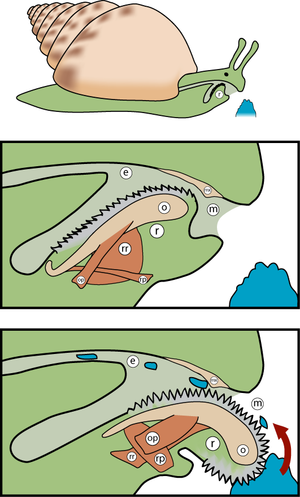Nutrition
Snails eat a wide variety of food depending on their environment in which they live. Terrestrial snails are herbivores, which means they only eat organic plant material(Carnegie Museum of Natural History, 2011). Since snails have an open circulatory system and are not able to metabolize quickly, they are slow moving (Ghesquiere, 2007). A lot of their time is spent crawling to seek out available food (Carnegie Museum of Natural History, 2011).
Contrary to what you would expect, snails do not possess teeth to chew
their food. Instead, all gastropods use a radula
to scrape off algae, fungi, and seaweed from the surrounding environment (
Figure 1. Snail eating organic material
Often, snails will be active and feed at night, especially during humid weather conditions (Carnegie Museum of Natural History, 2011). To find food, these gastropods use chemoreceptors on the tentacles in order to sense where to find food (Carnegie Museum of Natural History, 2011). When food is found, the snail will bring it toward their mouth and begin rasping with their radula. The radula is made up of coarse teeth made of chitin that move back and fourth, and in and out of the mouth (Carnegie Museum of Natural History, 2011).
After ingestion, muscular contractions move the material down the esophagus where digestive enzymes break down the food (Carnegie Museum of Natural History, 2011). The food material is then sent to the gastric pouch and then to the digestive gland where the nutrients are absorbed and waste is excreted through the intestine and rectum (Carnegie Museum of Natural History, 2011).
Figure 2. The radula in action.
Diagram description:
e= esophagus
m= mouth
r= radula
Learn more about the reproduction of Hawaiia minuscula

